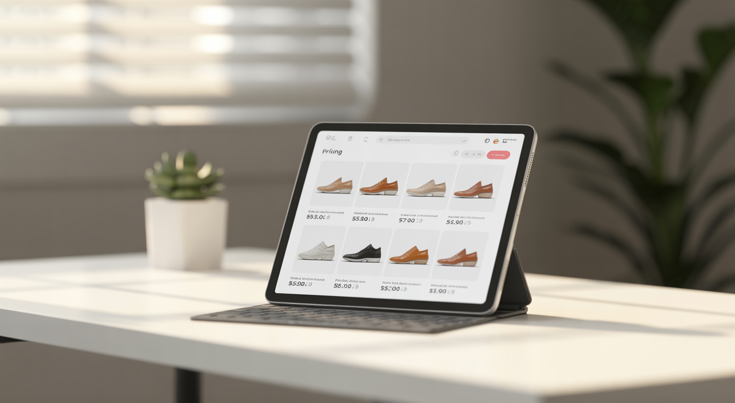Winning the e-commerce race with smarter competitor price tracking

The digital marketplace has become intensely competitive. E-commerce sales reached $5.8 trillion in 2023 and continue growing toward $8.1 trillion by 2026. Smart competitor price tracking now serves as a critical tool for retailers seeking to maintain market position while protecting profit margins in this dynamic environment.
The current e-commerce pricing landscape
Today’s online retail environment presents unique pricing challenges. E-commerce represents 20% of total retail sales globally, with projections reaching 25% by 2025. Mobile commerce generates 59% of all online transactions, fundamentally reshaping consumer behavior patterns.
Consumer expectations have shifted dramatically. Research shows that 80% of purchasing decisions depend on competitive pricing. Cart abandonment rates reach 76.22% worldwide, often triggered by price dissatisfaction during checkout.
Price comparison platforms drive 20% of e-commerce traffic across product categories. These tools provide consumers instant access to competitive pricing data, forcing retailers to maintain constant market vigilance.
“The digital era has meaningfully changed the environment and requires an overhaul of retailers’ pricing strategy and capabilities.”
McKinsey research demonstrates that traditional approaches struggle with current market dynamics. Retailers must adapt strategies to address today’s speed and sophistication requirements.
Manual monitoring creates significant disadvantages. Teams spend hours collecting data that becomes outdated before implementation. Market conditions shift faster than human analysis accommodates.
Why traditional pricing methods fall short
Legacy systems operate on outdated assumptions. Static pricing models expect stable conditions, yet competitors adjust prices multiple times daily. Seasonal fluctuations occur rapidly while consumer preferences evolve continuously.
Response time limitations plague manual efforts. Teams gathering competitor intelligence often discover opportunities have disappeared. Competitors capitalize on pricing gaps while others struggle with outdated information.
Scale presents challenges for growing businesses. Managing hundreds of products across multiple competitors overwhelms human capacity. Resource allocation becomes inefficient when teams dedicate excessive time to routine tasks.
The strategic advantage of automated price tracking

Intelligent tracking systems transform pricing from reactive to proactive processes. Real-time intelligence enables businesses to identify opportunities as they emerge, rather than after competitors gain advantages.
Automated monitoring provides comprehensive market visibility exceeding human capabilities. Systems track competitor prices across channels simultaneously while analyzing trends and identifying patterns. This supports sophisticated strategies beyond simple matching.
Data-driven insights reveal competitor behaviors, seasonal trends, and market dynamics informing broader strategies. Companies discover when competitors launch promotions, how they respond to changes, and where gaps create opportunities.
Financial impact proves substantial. Research shows 1% pricing improvements translate to 6% profitability effects. This multiplier makes pricing optimization among the highest-leverage business activities.
Key features that make price tracking smarter
Modern solutions incorporate artificial intelligence to overcome traditional limitations. AI-powered systems navigate protected websites, extract accurate information, and handle comprehensive monitoring scale.
Advanced analytics transform raw data into actionable intelligence. Price history reveals trends and seasonal patterns informing strategic planning. Predictive models forecast movements based on historical data and market signals.
Integration capabilities connect pricing intelligence with existing systems. API connectivity enables automatic flows while repricing rules adjust prices based on strategies. This eliminates manual entry and reduces response times significantly.
Implementing smart price tracking best practices

Strategic implementation begins with careful product selection. Focus efforts on key value items significantly impacting customer perception and business performance. These include high-volume products, margin leaders, and competitively pressured items.
Essential considerations for effective implementation:
- Direct competitor monitoring – Track primary rivals while maintaining market leader awareness
- Channel-specific dynamics – Account for marketplace versus direct sales variations
- Geographic adaptations – Adjust strategies for regional market differences
- Inventory integration – Connect pricing with stock levels and fulfillment costs
Pricing rule development protects objectives while enabling responsiveness. Establish minimum margin thresholds preventing destructive wars. Create deviation limits maintaining brand positioning integrity.
Performance measurement ensures strategies deliver results. Track conversion rates, margins, market share, and acquisition costs regularly. Analysis reveals optimal approaches for different categories and conditions.
Avoiding common pitfalls
Many businesses compete solely on price, creating destructive dynamics eroding profitability. Smart tracking should inform strategic positioning rather than automatic matching.
Over-reliance on automation without oversight leads to suboptimal outcomes. Technology should enhance decision-making rather than replace strategic thinking. Maintain control while leveraging automation for collection and adjustments.
Quality control becomes critical when processing large data volumes. Implement validation procedures ensuring accuracy and consistency. Inaccurate information leads to poor decisions damaging competitiveness.
The future of e-commerce pricing
Artificial intelligence continues advancing pricing sophistication. Predictive models forecast changes with increasing accuracy while behavior analysis enables personalized approaches.
Real-time demand sensing optimizes revenue capture. Omnichannel consistency becomes important as customers expect seamless experiences across touchpoints.
Market research indicates strategies must account for channel dynamics while maintaining brand coherence and positioning integrity.
Regulatory considerations may shape future practices, particularly around algorithmic pricing and market manipulation. Businesses should stay informed about requirements and ensure compliance.
Conclusion
Smart competitor price tracking has evolved from optional to essential. Today’s environment demands sophisticated systems providing strategic advantages beyond simple matching.
Successful companies leverage intelligent tracking to optimize revenue and profitability while maintaining positioning. Real-time intelligence, analytics, and automated capabilities create sustainable advantages in an accelerating marketplace.
![]()
The post Winning the e-commerce race with smarter competitor price tracking appeared first on Container News.
Content Original Link:
" target="_blank">





























































